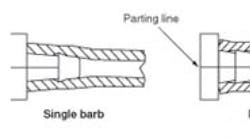If you've seen the 1998 remake of Alfred Hitchcock's classic movie, Rear Window, you saw how a plastic tube slipping off a pneumatic fitting can pose life-threatening consequences. The movie showed actor Christopher Reeve — a quadriplegic in real life — lying in bed and breathing through a respirator. Suddenly, a plastic tube slips off its barbed fitting, and Reeve's character is starved of oxygen while a nurse frantically tries to find which of several tubes needs to be reconnected.
Consider one of the most basic designs — the barbed fitting. Barbs on the outer surface of this fitting are designed to grip the ID of plastic tubing. Tubing is installed by pushing it over the barb. This action stretches the tubing, after which an interference fit holds the tubing onto the barb. The barb's angle makes it easy to push tubing over it in one direction but resists pulling of the tubing in the opposite direction.
Does more mean better?
Many fittings have two, three, or more barbs. The apparent reasoning is that if one barb holds well, two will hold even better. However, this reasoning often does not hold true. Even this simple aspect of fitting configuration can greatly affect the success of an application. Here's why: Due to the shape of a barb, only the first barb on a fitting can be produced on injection molding equipment without a parting line. Any additional barbs must have parting lines, otherwise, the fitting could not be removed from the mold.
The discontinuities of parting lines create potential leak paths, and parting lines become more pronounced as the production tooling wears. Thus, multi-barb fittings have an inherently higher likelihood of leakage.
Two other problems exist with multiple-barb fittings. First, it is impossible to fabricate tooling that creates a perfectly sharp peak on each barb of a molded multiple-barb fitting. Because it occurs at the mold parting line, only the first barb can have a sharp peak; subsequent barbs have rounded peaks as a result of the machining or EDM process used to form the barbs in the mold. Sharp peaks are critical to the performance of the connection. Second, multiple barb fittings may not be spaced far enough apart to allow the tubing to relax behind the first barb. If the tubing bridges from barb to barb, there is no uninterrupted interface with the fitting. This condition can compromise the pressure and tensile capacities of the connection.
Other considerations
Tubing material is another important factor. A multi-barb fitting may work well with soft silicone tubing if sufficient distance exists between the barbs and the silicone rubber is elastic enough to relieve strain in that area. However, the same fitting could be a disaster if mated with nylon tubing. Nylon is much stiffer than silicone, so that same spacing between barbs could be inadequate to relieve strain in the nylon. The nylon tubing may not fully contract around the second barb, permitting leakage and reducing the connection's ability to resist tubing pull off.
Matching the barb design to the tubing material used is also important, especially for automated assembly. The barb on a fitting used with soft silicone rubber tubing should have a higher peak than the barb on a fitting designed for nylon tubing. If a silicone rubber barb design was used for nylon tubing, greater force would be needed to fully seat the nylon tubing onto the fitting. Conversely, if a barb designed for use with nylon is used with silicone rubber, the connection may not have sufficient strength to resist pull off. In the case of a bad mismatch, the barb may even dig into the ID of the tube and actually cause the tube to tear if it is pulled hard enough.
The best practice is to have the fitting manufacturer supply a barb design with the best combination of sealing integrity, high pull off strength, and low assembly force for the type and size of tubing that will mate with it. A well-made single-barb design has no parting line and a sharp peak on the barb, allowing it to bite into the tubing. Then the cylindrical surface behind the barb allows the tubing to relax against the fitting.
The result is a leak-tight connection that meets the application's tensile and pressure specifications. Suppliers offering a variety of single-barb designs, tailored for use with specific tubing materials and application conditions, are likely to have the widest range of available alternatives.
For more information, call Value Plastics Inc., Fort Collins, Colo., at (970) 267-5200 or visit www.valueplastics.com.


